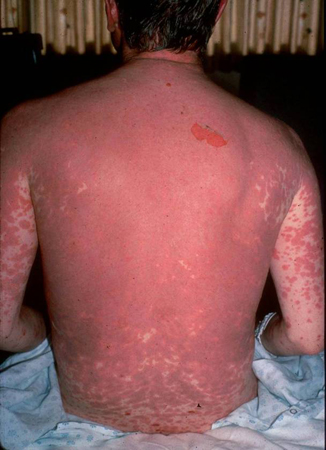Urgent considerations
See Differentials for more details
Toxic epidermal necrolysis (TEN)/Stevens-Johnson Syndrome (SJS)
TEN/SJS must be recognised immediately, as this is a potentially life-threatening condition. The most commonly associated drugs include sulfa drugs, nevirapine, anticonvulsants, non-steroidal anti-inflammatory drugs, and allopurinol.[61][62]
Influenza-like symptoms usually precede eruption by a few days. Early phases include diffuse redness or macular lesions with purpuric centres that may coalesce, blister, and then slough. These skin lesions usually begin on the trunk or face and then spread outwards, and commonly involve mucous surfaces.
A detailed history and physical examination, including charting of drugs used over a given time period, often help in establishing diagnosis.[61] Common laboratory investigations include full blood count with differential, liver function panel, basic metabolic panel, and skin biopsy. With ocular involvement, urgent ophthalmic consultation and evaluation are needed. Discontinuing potential causative drugs is very important.[Figure caption and citation for the preceding image starts]: Toxic epidermal necrolysisCommon skin diseases in HIV-infected patients in the antiretroviral era. IAS-USA 2007; used with permission [Citation ends].
Use of this content is subject to our disclaimer